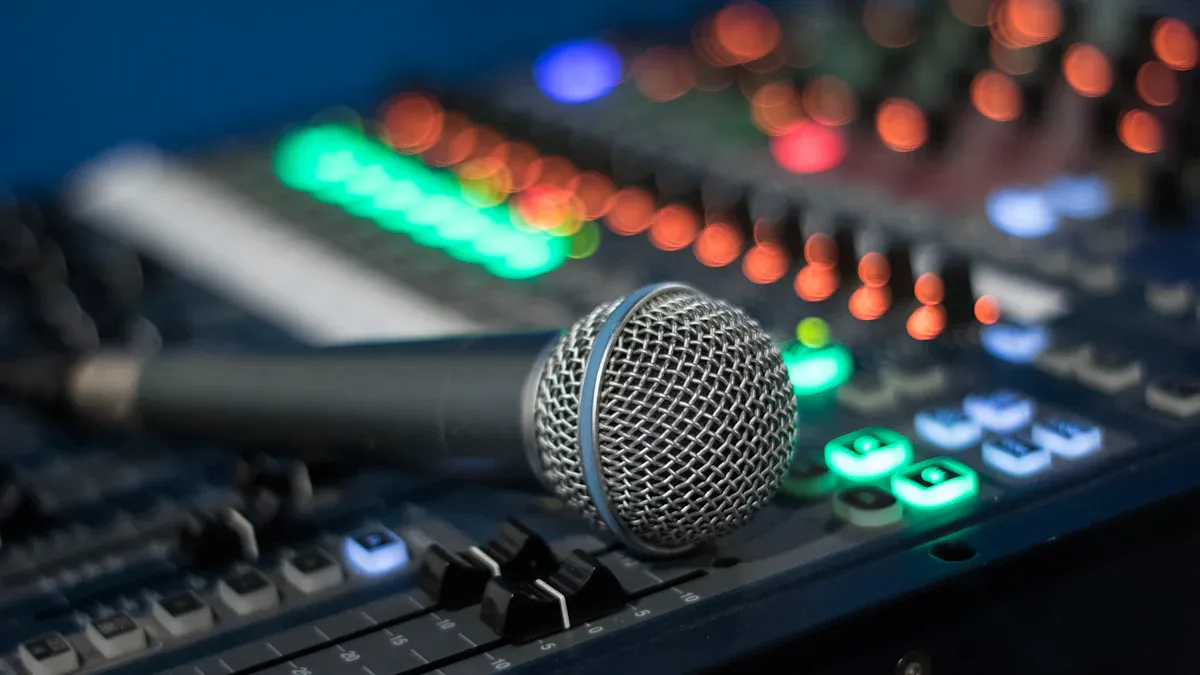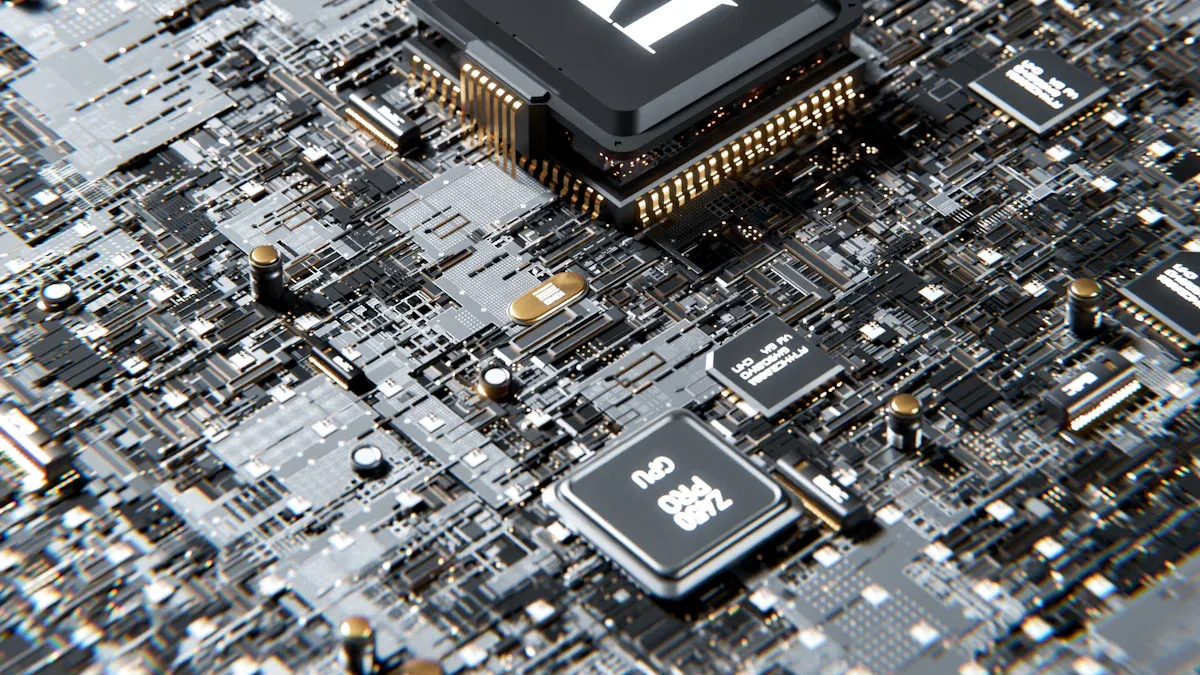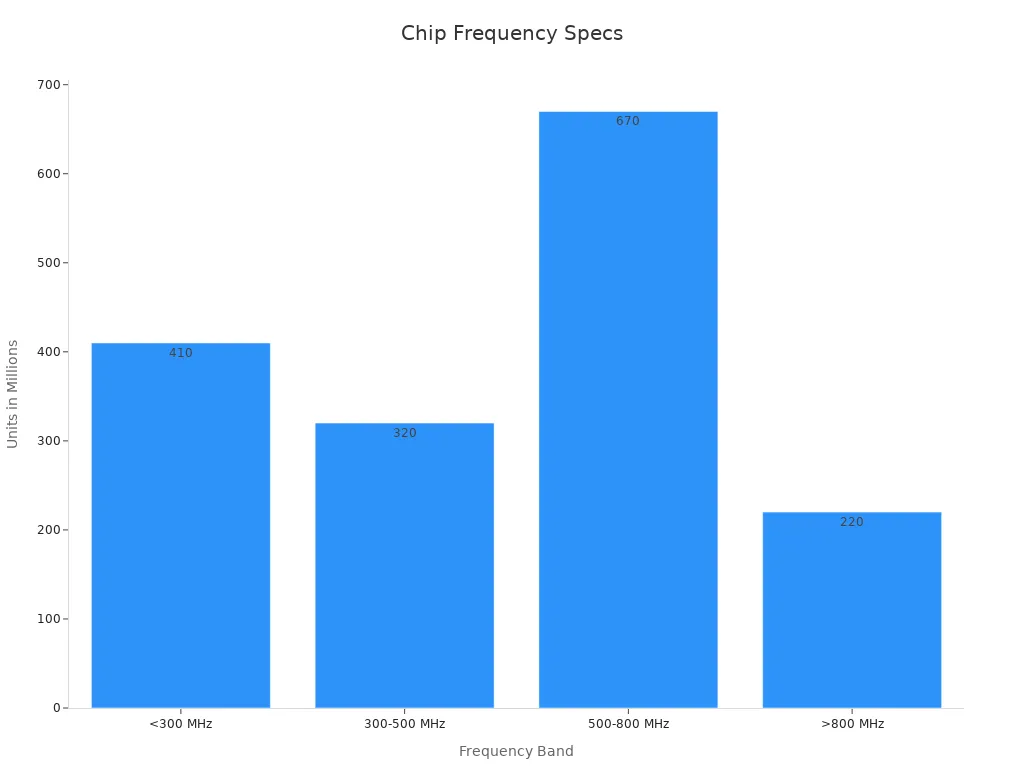What Is an Audio Signal Processor Chip and How Does It Work

An AUDIO SIGNAL PROCESSOR chip is a specialized microchip that changes and improves sound signals in electronic devices. It shapes how music, voices, and other audio are heard by controlling features like volume, tone, and effects. Many modern devices, such as smartphones and smart speakers, use these chips to deliver clear, high-quality sound. The rapid growth of the audio IC market, expected to reach $45.2 billion by 2027, shows how important these chips have become for better audio experiences.
Statistic / Metric | Value / Detail |
|---|---|
Audio IC Market Size (2027 projection) | USD 45.2 billion |
CAGR (2021-2027) | 7.4% |
Key IC Types | Audio amplifiers, audio DSPs, audio converters, audio processors |
Major Application Segments | Mobile phones, smart home & IoT devices, automotive, headphones, home entertainment systems |
Key Takeaways
Audio signal processor chips improve sound by changing and enhancing audio signals in real time, making music and voices clearer and richer.
These chips convert sound from analog to digital, process it quickly using special math, then convert it back to analog for high-quality playback.
They are widely used in smartphones, smart speakers, cars, and professional audio gear to deliver better sound and support features like noise reduction and voice commands.
Advanced chips save energy, reduce delays, and enable smart features like AI voice recognition and 3D audio for a more immersive experience.
While powerful, these chips face challenges like limited converter resolution and processing speed, but ongoing improvements continue to enhance their performance.
AUDIO SIGNAL PROCESSOR Chip Basics

What It Is
An AUDIO SIGNAL PROCESSOR chip is a small but powerful microchip found in many electronic devices. This chip takes sound signals and changes them using fast math operations. It can turn real-world sounds, like music or voices, into digital data. Once the chip has the digital data, it can quickly adjust the sound by adding effects, removing noise, or changing the tone. After processing, the chip can turn the digital data back into sound that people hear.
These chips use special designs to handle audio tasks better than regular computer chips. They include parts like multiplier-accumulator units and pipelined processing, which help them work faster and use less power. Many devices, such as smartphones, headphones, and smart speakers, use AUDIO SIGNAL PROCESSOR chips to make sure the sound is clear and high quality.
Note: AUDIO SIGNAL PROCESSOR chips are important for real-time audio tasks. They can process many sounds at once, which is helpful for things like video calls, music streaming, and voice commands.
The table below shows some key technical specifications of these chips:
Specification Aspect | Details / Range / Units |
|---|---|
Max Clock Frequency | <300 MHz (410M units, simple devices), 300-500 MHz (320M units, portable speakers), 500-800 MHz (670M units, consumer wireless audio), >800 MHz (220M units, spatial audio, AI) |
Data Bus Width | 32-bit (1.23B units, wearables, mobile, infotainment), 64-bit (280M units, high-res, multi-channel), Hybrid 24/32-bit (390M units, industrial/professional) |
Applications | Consumer Audio (1.1B units: headphones, ANC, Bluetooth codecs), Automotive Audio (320M units: zonal entertainment, ADAS), Computer Audio (290M units: gaming, conferencing), Others (190M units: broadcasting, industrial) |
Power Consumption | >60% new DSPs with active current <2 mA, standby <100 µW; focus on power optimization and form factor reduction |
AI & Low-Latency Features | 140M DSPs with edge-AI support (smart speakers, home hubs); new products with AI speech analytics, low-latency audio, multi-band Bluetooth LE Audio support |
Automotive Requirements | High channel density, real-time audio feedback, ISO 26262 safety compliance, multi-zone audio in electric/autonomous vehicles |
Leading Companies | Texas Instruments (430M units), Qualcomm (390M units), Cirrus Logic, NXP Semiconductors investing heavily in R&D |
Market Trends | Shift to 500-800 MHz DSPs for TWS, integration of AI voice recognition, growing automotive DSP demand, OTA firmware updates increased by 35% |
Investment & R&D | $720M+ invested in 2023-24; TI $220M expansion, Qualcomm $170M lab, Analog Devices $90M hub, Cirrus Logic $60M center, NXP $50M miniaturization |

Core Purpose
The main job of an AUDIO SIGNAL PROCESSOR chip is to improve and control sound in real time. This chip can change how music, speech, or any audio sounds by using special math operations. It can remove unwanted noise, boost certain sounds, and add effects like echo or surround sound. These changes happen very quickly, so people hear better sound without delay.
AUDIO SIGNAL PROCESSOR chips help devices save energy and work faster. They take over audio tasks from the main computer chip, which lets devices run longer on battery and stay cool. For example, in smartphones, these chips decode music files, run noise cancellation, and help with voice commands. In cars, they manage sound for entertainment and safety alerts.
Phones are the dominant end-use segment for audio DSP chips.
Asia-Pacific region leads the market with the highest CAGR of 10.6% during 2020-2027.
Key drivers include increased use of DSP chips in consumer electronics, wireless connectivity adoption, and automotive applications.
Challenges include increased product cost due to DSP integration.
Major companies involved include Texas Instruments, Analog Devices, Broadcom, and others.
Technological advancements such as AI-driven sound processing and 3D audio enhance adoption.
COVID-19 caused a temporary slowdown but growth is expected to resume strongly post-2021.
AUDIO SIGNAL PROCESSOR chips also support new features like voice recognition and 3D audio. These features make devices smarter and more fun to use. As technology improves, these chips become even more important for delivering high-quality sound in all kinds of products.
How the Chip Works
Signal Flow
An AUDIO SIGNAL PROCESSOR chip manages sound by following a clear path from input to output. The process starts when an audio signal enters the chip through a connector pin. The chip first uses an analog-to-digital converter (ADC) to change the incoming sound from an analog wave into digital data. This digital data moves to the main processing part of the chip. Here, the chip uses fast math operations to adjust the sound. It can remove noise, add effects, or change the tone. The chip processes each sample very quickly, often thousands of times per second. For example, some chips call a process function 16,000 times every second to handle each piece of sound data. After processing, the chip sends the digital data to a digital-to-analog converter (DAC). The DAC turns the digital data back into an analog signal. This final signal leaves the chip and goes to speakers or headphones, where people can hear the improved sound. Engineers can measure the signal at different points on the board to check how the chip changes the audio.
Tip: The signal flow inside an AUDIO SIGNAL PROCESSOR chip ensures that every sound gets processed in real time, so users hear clear and high-quality audio without delay.
Analog and Digital Processing
The AUDIO SIGNAL PROCESSOR chip works with both analog and digital signals. It uses special parts to convert and process these signals. The chip must handle the differences between analog and digital processing to keep the sound accurate and clear.
ADCs (analog-to-digital converters) use comparators in flash ADCs or use a method called successive approximation. This method starts with a guess and adjusts it step by step to match the input voltage.
Successive approximation ADCs begin with a middle value and change it bit by bit until they find the closest match to the input signal.
DACs (digital-to-analog converters) often use resistor networks or ladder networks. These networks add up weighted bits to rebuild the analog signal from digital data.
High-resolution DACs need very precise resistors. Ladder networks help keep the output accurate even when the signal has many levels.
The chip must consider things like resolution (how many bits it uses), how fast it samples the signal, and how it filters out unwanted parts. These factors affect how well the chip converts and processes sound.
ADC resolution sets how many steps the chip can use to describe the sound. More steps mean better detail and accuracy.
DACs turn digital numbers back into smooth analog waves by adding up the right amounts for each bit. The chip needs precise parts to keep the sound true to the original.
The chip uses different filtering methods for ADCs and DACs. These filters help prevent problems like aliasing, which can make the sound unclear.
Digital processing inside the chip uses math to change the sound. The chip can boost certain frequencies, remove noise, or add effects like echo. It does all this in real time, so the sound stays in sync with what is happening.
Inside the Chip

Key Components
An AUDIO SIGNAL PROCESSOR chip contains several important parts that work together to handle sound. Each part has a special job in the signal path. Engineers use schematic symbols to show these parts in circuit diagrams. These symbols help people understand how the chip works inside.
Microphone: Captures sound from the environment. The symbol looks like a small vertical cylinder.
Speaker: Outputs sound after processing. The symbol often appears as a cone or a box with sound waves.
Telecom/RF Ports: Allow signals to enter or leave the chip.
Pre-filter: Removes unwanted high-frequency noise from the input.
Analog-to-Digital Converter (ADC): Changes analog sound into digital data.
Digital Signal Processor (DSP) Core: Processes and analyzes the digital signal.
Digital-to-Analog Converter (DAC): Converts the processed digital data back into an analog signal.
Post-filter: Cleans up the output signal before it reaches the speaker.
Amplifiers: Boost the signal strength during different stages.
Note: These symbols and components follow global standards, so engineers everywhere can read and build circuits with the same understanding.
Processing Functions
The chip uses advanced processing functions to improve sound quality and add features. The DSP core runs special algorithms that change the audio in real time. These functions include filtering, noise reduction, and adding effects like echo or surround sound. The chip can use fixed-point or floating-point math to do these jobs quickly and accurately.
Many chips use parallel processing to handle more than one sound at a time. This helps reduce delay and makes the audio smoother. Some chips use special hardware, like ASICs or FPGAs, to speed up these tasks. Others combine a microcontroller and a DSP core for even more control.
Feature/Aspect | Description/Empirical Data |
|---|---|
Instruction Set | Specialized instructions for fast math, like multiply and accumulate |
Architecture | Uses Harvard-based design, SIMD operations, and single-cycle MAC for speed |
Performance Metrics | Example: 3.5 million instructions per second (MIPS) for Motorola 56001 DSP |
DSP Functions | Real-time filtering, fast Fourier transform (FFT), and noise reduction |
Hardware Platforms | Runs on ASICs, FPGAs, and multi-core CPUs for better speed and lower latency |
FPGA Benefits | Offers reconfigurability and parallel computing for high sampling rates |
These processing functions allow the AUDIO SIGNAL PROCESSOR chip to deliver clear, high-quality sound in many devices.
Applications and Impact
Consumer Devices
Audio signal processing technology shapes the way people experience sound in everyday gadgets. Many consumer devices, such as smartphones, smart home speakers, and premium TVs, rely on advanced chips to deliver clear and rich audio. The market for these chips continues to grow. In 2021, the market size reached $29,883 million, and experts project it will rise to $52,900 million by 2030, with a steady growth rate of 7.4% each year.
Aspect | Details |
|---|---|
Market Size (2021) | USD 29,883 million |
Projected Market Size (2030) | USD 52,900 million |
CAGR | 7.4% |
Leading Segment by Revenue | Audio CODEC (CAGR 9%) |
Second Largest Segment | Audio DSP chips |
Top Applications | Phones, smart home devices, IoT gadgets, home audio, premium TVs |
People want better sound in their devices. This demand drives companies to use more efficient and powerful chips. Phones hold the largest share of this market, growing at 7.7% each year. Smart home and IoT devices also show strong growth. New wireless audio technologies, like those from Noveto Systems, push the industry forward.
DSP chips now power surround sound in home theaters and premium TVs.
Companies focus on making chips that use less energy and cost less.
Advanced audio features in consumer devices help the market expand.
Professional and Automotive Uses
Professional audio equipment and car audio systems benefit greatly from digital signal processing. In cars, these chips improve clarity and reduce noise, making music and voice commands easier to hear. They support features like equalization, time alignment, and crossover controls, which help create a balanced and immersive sound.
Real-time processing removes unwanted sounds and adjusts audio for different environments.
Integrated ADCs and DACs convert signals smoothly, keeping sound quality high.
Fast algorithms allow for instant correction of audio signals, even while driving.
Oversampling and noise shaping in DACs further enhance the listening experience.
Professional audio gear, such as studio mixers and broadcasting equipment, uses these chips to handle complex audio tasks. The chips support high-fidelity sound, which is important for music production and live events.
Sound Quality Benefits
Digital signal processing brings clear advantages to sound quality. High-resolution audio formats, with sampling rates of 96 kHz or higher and 24-bit depth, capture more detail than standard CDs. These formats let listeners hear subtle details and enjoy a more lifelike experience.
Modern car audio systems use DSP chips to optimize high-resolution audio, making music sound more accurate.
High-res audio supports lossless streaming, which audiophiles and music lovers appreciate.
The technology transforms car cabins into concert-like spaces, raising enjoyment and engagement.
Note: The move from compressed audio to high-resolution formats shows how digital processing improves sound for everyone, from casual listeners to professionals.
Pros and Cons
Advantages
Audio signal processing technology brings many benefits to modern devices. These chips help create better sound and smarter features.
Some key advantages include:
High-precision sound control lets users enjoy music and speech with less distortion.
Real-time noise reduction and signal optimization keep audio clear, even in busy places.
Equalization, echo cancellation, and spatial audio make listening more immersive.
Voice input accuracy improves with background noise suppression and beamforming, especially in small, battery-powered devices.
AI and machine learning allow the chip to recognize different environments and adjust sound for each situation.
Low-power designs help devices like wireless earbuds and smart speakers last longer on a single charge.
System-on-chip designs combine audio processing with other functions, saving space and lowering costs.
The growing demand for high-resolution audio, smart voice assistants, and AR/VR drives new features and better performance.
Tip: Many smart home devices and cars now use these chips to deliver high-quality sound and advanced voice features.
Limitations
While audio signal processors offer many strengths, they also face some technical challenges. The table below shows common limitations found in high-demand applications:
Metric / Factor | Description / Limitation |
|---|---|
Bus Cycle Counts | DSPs need several cycles for instruction and data transfers, which can slow down processing. |
Pipeline Execution Order | Parallel pipelines may cause instructions to run out of order, making debugging harder and increasing delays. |
Built-in A/D and D/A Converter Resolution | Many chips use 8- or 12-bit converters, which may not meet the needs of high-quality audio. |
Converter Speed | Slow converters can limit real-time audio performance. |
Instruction Set Complexity | Some instruction sets need more cycles or instructions, affecting speed and efficiency. |
Fixed-point vs Floating-point | Fixed-point chips have less dynamic range, which can lower audio quality in some cases. |
Real-time Behavior and OS Overhead | Operating system tasks and interrupts can reduce real-time audio performance. |
Bus Widths | Unusual bus widths may make it harder to connect with other system parts. |
Note: Designers often add external converters or use floating-point chips to overcome some of these limits, but this can increase cost and complexity.
Audio signal processing technology has changed how people experience sound. Digital chips now handle tasks once managed by many analog devices. These chips improve clarity, reduce noise, and make music and speech more lifelike. Research shows digital processing offers more flexibility and better performance than older analog systems. Tests with high-end converters reveal that advanced chips can boost resolution, detail, and realism in audio. Readers who want to learn more or have questions about audio technology can explore further or reach out for advice.
FAQ
What does an audio signal processor chip do?
An audio signal processor chip changes sound signals to improve how people hear music, voices, or effects. It can remove noise, boost certain sounds, and add features like echo or surround sound. Many devices use these chips for better audio quality.
Where can people find audio signal processor chips?
People can find these chips in smartphones, smart speakers, headphones, cars, and TVs. Many modern devices use them to deliver clear and rich sound. Engineers also use them in professional audio equipment and broadcasting systems.
How does an audio signal processor chip help with noise reduction?
The chip uses special math to find and remove unwanted sounds from the audio. It can filter out background noise during calls or music playback. This helps people hear voices and music more clearly, even in noisy places.
Can an audio signal processor chip improve voice commands?
Yes! The chip makes voice commands easier to understand by reducing background noise and focusing on the speaker’s voice. This helps smart devices respond more accurately to what people say.
Do all audio signal processor chips support high-resolution audio?
Not all chips support high-resolution audio. Some chips work with standard sound quality, while others handle high-res formats with more detail. People should check the device’s specifications to see if it supports high-resolution audio.
See Also
Understanding IC Audio Signal Processors And Their Main Features
Exploring IC Voice Processors And Their Operational Mechanisms
An Overview Of Computer Chips And Their Functionality Explained
How Communication Chips Function And What They Are About
Understanding Programmable Logic Chips And Their Working Principles
